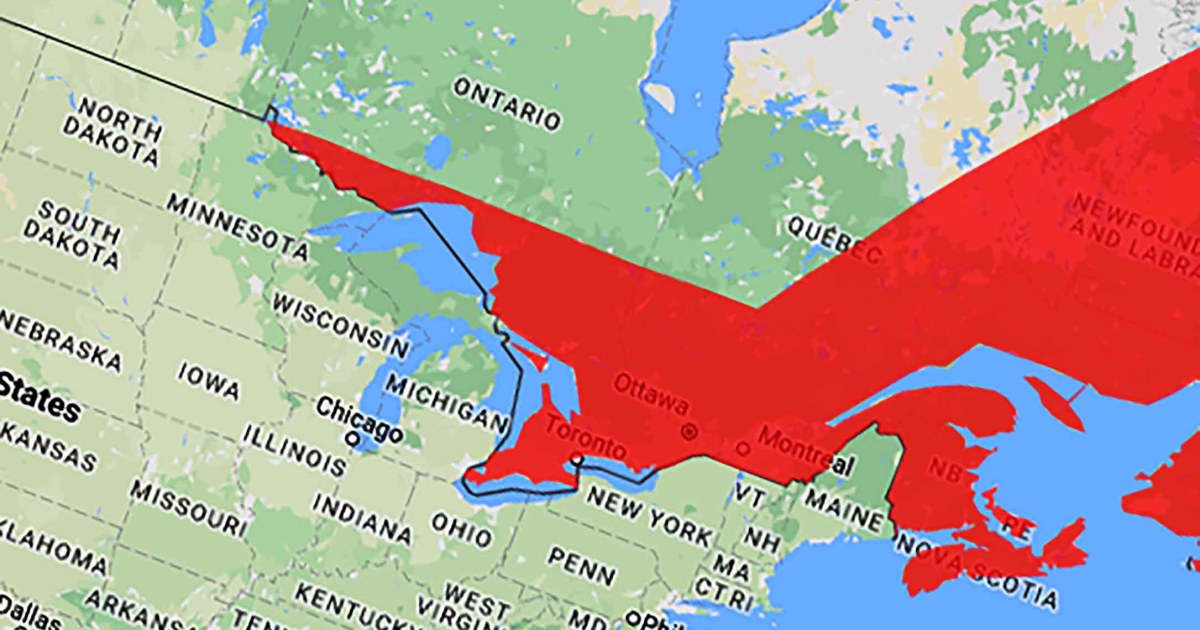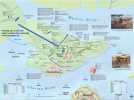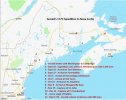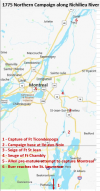Section 6 – Montgomery campaigns north – “O Canada! Our home and native land!”
Developments with Montgomery in the Northern campaign.
Phillip Schuyler and Richard Montgomery use Ile-aux-Noix (Island in the Richelieu River, North of Lake Champlain) as a base of operations against Forts St Jean and Chambly on the Richelieu River defending Montreal.
Montgomery is unsuccessful in his first two attempts to subdue Fort St. Jean. His troops are green, all militia units.
He is unsuccessful but not undone. To his advantage, reinforcements continue to arrive in camp. Henry Knox has already arrived at Ticonderoga and is bringing up the siege cannon. Local militia sympathetic to the Patriot cause under James Livingston aid in the campaign. The additional 200 troops that came with Knox will be deployed forward at Fort Chambly with Livingston. Montgomery’s forces are arrayed with 500 troops at Chambly and 2000 arrayed against Fort St. Jean.
The siege of Chambly begins on September 15th. The fort with it supplies will succumb to the Patriots on October 12th.
Montgomery begins his third attempt to besiege St. Jean on September 17th. Henry Knox has the artillery from Ticonderoga in place on October 1 against St Jean. His first placement knocks out a British warship on the Richelieu which had been giving the Patriots problems. Next, upon the advice of James Livingston, Montgomery has Knox travel upriver to place additional artillery against Chambly. Finally, Knox returns back to St. Jean and improves his positions and adds three more batteries. Chambly falls on October 12th with St. Jean surrendering on October 15th.
With these captured forts are needed supplies and ammunition that the British fail to destroy.
On September 25th, Ethan Allen fails in a direct attempt to seize Montreal at the battle of Longue-Pointe. He is captured in the process. Montgomery chuckles at the ill fated attempt as his plans are to secure the Richelieu River and then take Quebec (city); he planned on largely leaving Montreal as an open city.
Aaron Burr makes good time with his troops to arrive to Montgomery on the Richelieu on October 8th. Montgomery sent them forward with other units as a 700 man blocking force to Sorel, as he was finishing off Fort Saint-Jean and Fort Chambly. They prevented British reinforcements from Sorrel to reach Fort Saint-Jean. These added troops were also able to search and prevent supplies and refuges from traveling to and from Montreal to Quebec.
In Montreal, Guy Carleton has two choices in October; he can attempt to break the siege at St. Jean or attempt to break through the Americans who have effectively shut down both sides of the St. Lawrence west of Sorel.
Carleton chooses to abandon Montreal and break through to Quebec.
October 8th – Carleton fails to break through Burr and retreats back to Montreal
October 15th - Sir Guy Carlton is captured by Burr while posing as a commoner fleeing Montreal to Quebec.
October 22nd – Montgomery captures Montreal. There is no formal occupation of Montreal as Montgomery planned. Only local militia, units loyal to Montgomery and 100 Patriot soldiers defend Montreal. They were met with little resistance. Indian attacks were their biggest worry. One of the strong points of Montgomery is that he is able to listen and perceive what the Canadians would like. This goes a long way in establishing trust and good intentions between the lower colonies and Canada.
October 25th – Burr and 500 men at Sorrel begin the advance to Quebec. 200 men are left to guard Sorel and the Richelieu.
October 27th – Montgomery with the main force sets out for Quebec
November 9th – Burr with 500 men reaches Quebec and takes position
November 16th – Montgomery with 800 men (a significant portion of his forces had enlistments up) reaches Quebec. These men are along with 500 from Burr, and 200 from Livingston.
With 1500 men, the siege of Quebec begins on November 17th.
December 4th – Henry Knox arrives with cannon to add to the siege.
Montgomery does not press the siege. From spies within the city, he learned that the garrison was teetering on surrendering. (OTL Carlton was able to reach Quebec and shore up defenses). One push would do it. After a few weeks of staging the siege and preparing for an assault, Montgomery sprang into action. During this time, his artillery is shelling the defenses.
This final push came during a snow storm on December 31, 1775. Montgomery was able to win the city. He did this by repositioning most of his artillery along with Burr’s force assigned to demonstrate on one end of the city while he forced a breach of the outer walls at the other side. The artillery and the troops under Aaron Burr acted as a ruse to draw British attention away from where the main push would be. It worked as he was able to breach to outer defenses and then pour troops through on the other side. The British with their weakened morale surrendered soon after the outer walls were breached.
As the calendar turns to 1776, Montgomery has captured all of Canada. Now, can he capture the hearts of the Canadians?





